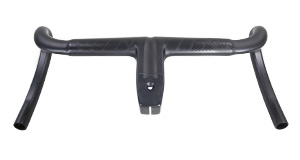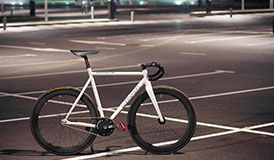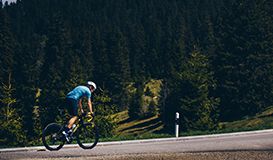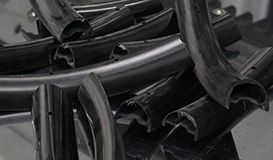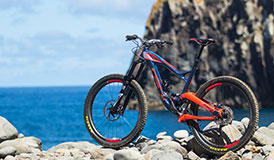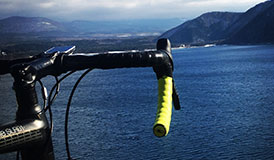Rider Profile

Name : Philippe
Origin : France/Hong Kong
Information : Height 175cm. Weight 70-73kg. Always had some kind of bike, wherever I found myself.
Specifications
Bike
Frameset : Carbonda 505 (M)
Groupset : Mostly Ultegra mechanical (shifters, derailleurs, originally 46/36 crankset)
Brakes : TRP mechanical
Quirks : Inline brake levers (32 teeth oval inner ring from TA evolution to replace 36 original)
Wheels-1
Rims : Light Bicycle R35 (F) R45 (R) without access holes (the R35 & R45 disc rims are not available online. Contact us to order them offline.)
Hubs : Novatec D411/D412SB 12/100mm 12/142mm Shimano Road 11s
Spokes : Sapim CX Ray
Nipples : Sapim aluminum black
Tires : Schwalbe Pro One tubeless 25mm front/30mm rear
Cassette : Sunrace 11-32
Wheels-2
Rims : Light Bicycle AR28 Disc (F) AR36 650b (R) without access holes (tubeless)
Hubs : Novatec D791/D792 28/28H
Spokes : Sapim CX Ray
Nipples : Sapim aluminum black
Tires : Panaracer gravelking SK, 700x38mm front/650x48mm rear
Cassette : Sunrace 11-36t
Road or gravel? Save or upgrade? Why choose, get all four with Light Bicycle wheels.
After having been through a number of generic bikes (from second-hand best qualified as (lovable) piece of junk to new aluminum Ultegra equipped fitness flat-bar bike (with V-brakes, and triple crankset, that was more than 10 years ago, oh, and Ultegra was 9 speed then)), I decided to get more serious and living in Hong Kong, with the proximity of China, I set to purchase a factory carbon cyclocross frameset on which I could refit all the bits and pieces of my hybrid.
It worked fine, saving more than 1kg in the process, then I kept on upgrading: changing gearing, buying touring handlebars (I wanted more positions, but also to keep the flat bar type trigger gear shifter), got new aluminum wheels (didn't want carbon rims with rim brakes). Having a fair idea of what I really wanted and not finding it in the shops at an affordable price (and I still would need to change some parts), I realized that for my next bike, I could get a better deal purchasing all the parts separately and putting the bike together.


My target was below 8 kg for weight and about a $2,000 USD budget for an all-carbon bike and wheelset.
I started to look for a disc brake carbon frameset to which I could fit two sets of wheels, one for sealed roads (half of the time), and the other for mixed terrains (the other half). I choose the Carbonda 505 frame because of its endurance-oriented geometry, making it more of a road bike on which you can put wider tires than a full-on gravel bike (by the way, there is a previous review of the carbonda CFR 505 frame on storytelling by a lady called Lydia, and she built her own wheels from AR36 disc rims - respect).
For the groupset, I got mostly mechanical Ultegra with a 46/36 crankset. GRX was just released but not widely available. I knew from the start I will replace the 36 inner chainring with a 32t oval from T.A. and did not get a clutch derailleur, not knowing how it will behave with the constant adjustment when using the oval chainring. Mechanical disk brakes from TRP (squeezing from both sides) which allows for inline levers, saving weight, complication and cost compared to hydraulic.
I decided to start first with the wheels for the road and went for a combo from Light Bicycle of R45 for the rear and R35 for the front, Novatec hubs with 24 spokes and straight pull for stiffness, aluminum nipples (no risk of salt on the road in Hong Kong). It was easy to choose and my order was confirmed in due time. I was rather excited to receive the pre-shipment pictures and of course the wheels. They were very well packed, with a beautiful finish, and perfectly true. They came somewhere between 1400-1450g - I don't have such a precise scale.
It was my first time to fit tubeless tyres (I chose 25mm section tyres that would come flush with the rims) and it went ok after a few tries. Soapy water was helpful, and the tyres nicely popped on the bed rims using a classic floor pump. Below 8kg without pedals was achieved, total cost $2,200 USD with parts purchased online, in China, and at my local bike shop.


And it was finally time for my first ride!
The wheels accelerated quickly and maintained good speed without a fuss. In real life, the light rotational weight is a bonus on the cycle lane in Hong Kong because traffic is high. For safe overtaking, it is often necessary to slow down quite a bit, but with those wheels, it is easy (and enjoyable) to regain speed swiftly: drop a couple of gears, apply a bit of power and they respond immediately.
On the road, they are the perfect all-rounder: light enough for climbing, a bit aero on the flat. Like a pair of comfortable shoes, you forget about them. They are silent except for a soothing hum from the tyre/road contact patch which is more pronounced when air pressure is increased and speed at a certain wind angle, a faint low pitch aero whistling.
I did hesitate a bit about the height of the rims when ordering. 35 or 45? 45mm is supposed to be more aero but there is a 30-40g penalty for the 10 mm, affecting acceleration negatively. For the front, 35mm was the way to go, making the steering livelier and less prone to wind gusts.
But for the rear? 45 or 35? I went for 45mm but with insight, I could have gone for 35mm. I might go a little faster with 45mm, but I am more interested in feel than in pure speed. I'd rather go back home with a smile than download data to check how fast I was.



It has been three years, and the wheels are running as smoothly as when new.
It has been three years, and the wheels are running as smoothly as when new, the only thing I did for maintenance was to have the rear wheel adjusted by my local bike shop as it was out of true by a couple of millimeters, after two years of use on less-than-perfect roads, going sometimes up and down the verge - some roads are rather narrow in HK and when going slow uphill, the verge is definitely safer.
The 25 mm tyres were fine in terms of performance, but I found the front end to be a bit skittish on rough terrains and the back end a tad uncomfortable for a long ride (I got a sub 200g Chinese-made saddle). I swapped the rear and front tyres after 6 months or so to even the wear but when it was time to replace them, I went for 30mm. More comfortable for sure, but the feeling was not the same, 50 extra grams per wheel might seem little, but at the front it made the steering quite a bit duller, and the acceleration was not as sharp. Overall the bike seems less lively, and more sedate.


Now, the 18mm R series has been replaced by the 21mm AR for more volume and comfort.
Now, the R series which had an internal width of 18mm has been replaced by the AR with an internal width of 21mm giving more volume and comfort without adding weight. Kudos to Light Bicycle for opening a new mold to update those rims.
But in my case, what to do? I got a suspension stem from redshift. It does add about 150g compared to a regular stem but filters road buzz and smaller bumps very well. I kept the 30 tyre at the back, and put back a 25 at the front so that I could inflate at higher pressure than before with better comfort and also better safety as the tyre keeps better contact with the road, which is particularly important in curvy descents on an imperfect surface.
The steering is livelier with a smoother feel because of the lighter inertia. In wheel weight, the hub weight is relatively unimportant because it is on the axe of rotation, but the further away from the hub (rim and tyre) the more it is felt, both in steering feel (because of gyroscopic effect) and acceleration (because of the higher momentum). It is also livelier because the diameter of the front wheel, with the tyre being smaller at the front than at the rear, alters the geometry, making the trail shorter (more on that in part two). The extra 150 grams on the stem are not felt at all.
About gearing, I found a 46 ring combined with an 11 cog enough as a top gear for the road. I will use it only in descent, by the time I run out of rpm, I am already too fast (ever experienced discovering a minefield of cow dung around a fast descent corner? We have feral cattle in Hong Kong). More important to me for road use is tight gearing. A Shimano cassette very commonly fitted as standard on bikes is the 11-34 which has a good spread but is going 11-13-15-17... I got a Sunrace 11-32, which is 11-12-13-14-15-17... (5 cogs instead of 3 from 11 to 15). The low end for steep ascent with 32 front and rear is good and ovality of 32 at the front helps, more details in Part 2.
I don't understand the logic of this commonly found combination of 50/34 crankset with 11-34 cassette for recreational road riding. Top end is unnecessarily high while being too gappy in the same time, just where it needs to be tight (big gap in lower gears is no problem, that's bail out mode).
If you have read so far, you are probably not put off by the technical stuff, there will be more in part 2 (frame geometry, trail, advantage of inner oval chainring (and not outer), in line brakes).
Can a road steed also work as a gravel mullet?



May 16th, 2023 | Light Bicycle
MORE ADVENTURES
Get in touch
Feel free to leave a comment if you have any questions or suggestions on our products or other issues.

Please leave your name here.
E-mail is required for further contact.
Please enter a message.
We use cookies for a better experience. Learn more.
Your Cookie Preferences
We use cookies to improve your experience on this website. You may choose which types of cookies to allow and change your preferences at any time. Disabling cookies may impact your experience on this website. You can learn more by viewing our Cookie Policy.
-
Cookies required to enable basic website functionality.
-
Cookies used to understand how the website is being used.
-
Cookies that are used to enhance the functionality of the website.
-
Cookies used to deliver advertising that is more relevant to your interests.
Aceept All Cookies
Save Preferences
Reject All Cookies
Save Preferences
Reject All Cookies
Accept All Cookies





